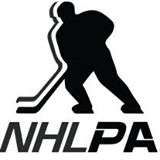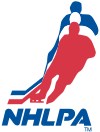National Hockey League Players' Association
 | |
| Full name | National Hockey League Players' Association |
|---|---|
| Founded | June 1967 |
| Members | 725 (2012-2013)[1] |
| Key people |
Donald Fehr Mathieu Schneider[2] |
| Office location |
|
| Country |
|
| Website | NHLPA.com |

The National Hockey League Players' Association (French: Association des joueurs de la Ligue nationale de hockey; AJLNH) or NHLPA is the union for professional hockey players in the National Hockey League (NHL). Created in 1967, the union negotiates and enforces fair terms and conditions of employment for NHL players.
The members of each NHL club elect a Club Player Representative and an Alternative Club Player Representative. Each Club Player Representative serves as a voting member of the NHLPA Executive Board. The Executive Director also sits on the Executive Board as a non-voting member.
Hockey is a sport with a strong sense of history, whose players take an active interest in the integrity and growth of the game. The NHLPA acknowledges the legacy work undertaken in the 1950s by the first Players Association President, Ted Lindsay, and helped establish the NHL Alumni to represent the rights of hockey's greatest family: its retired players. The NHLPA continues to advance the cause of the players' rights, strengthen its membership, and keep pace with the evolving world of professional hockey.
History
First organizing efforts (1957–1959)
The first NHLPA was formed in 1957 by hockey players Ted Lindsay of the Detroit Red Wings and Doug Harvey of the Montreal Canadiens after the league had refused to release pension plan financial information. The owners broke the union by trading players involved with the organization or sending them to the minor leagues. After an out-of-court settlement over several players' issues, the players disbanded the organization. Lindsay's struggle and the NHL's union busting efforts are dramatized in the movie, Net Worth.
Alan Eagleson era (1967–1991)
The association formed in June 1967, when representatives of the six NHL teams met and elected Bob Pulford their first president and appointed Alan Eagleson as its executive director.
To prevent the new NHLPA from suffering the fate of its predecessor, Pulford met with the owners of the NHL teams and demanded they recognize the new union or the union would seek official recognition from Canadian Labour Relations Board. Additionally, the players sought guarantees that no member of the new union would be punished for being a member. The owners acceded. In return, the NHLPA agreed that it should represent at least two-thirds of the active players in the NHL and that the players would refrain from striking for the duration of the agreement, so long as the owners did not contravene any terms or conditions.
Bob Goodenow era (1992–2005)
Eagleson stayed on until the end of 1991, when the players replaced him with Bob Goodenow. Eagleson went on to face criminal charges relating to his conduct during the time he worked at the NHLPA, and ultimately, on January 6, 1998, pleaded guilty in a Boston court to three counts of fraud, agreeing also to pay a fine of CA$1,000,000. The following day in Toronto, Eagleson pleaded guilty to another three counts of fraud and was sentenced to 18 months in jail.
Bob Goodenow would seek to restore respect and honour to the Association during his successful 13 years of service to the players as Executive Director. He led all NHLPA members through the strike of 1992, which most notably gave players the rights to the marketing of their own images. In 1994–95, he was at the helm as the players endured a lockout, ensuring that a fair deal was reached. A decade later, in 2004–05, the owners locked out the players again, becoming the first professional sports league to cancel an entire season. Goodenow would depart following the lockout, notifying the players of his resignation in July 2005.
Ted Saskin era (2005–2007)
As Goodenow stepped down, the members of the Association turned to long-time NHLPA Senior Director Ted Saskin as his successor, drawing on his experience within the Association.
The NHLPA Executive Board terminated the employment of Saskin as Executive Director and General Counsel on May 10, 2007, following alleged acts of misconduct. Toronto employment lawyer Chris Paliare concluded Saskin and executive Ken Kim, beginning in September 2005 through January 2007, covertly accessed player email accounts.
As a result of this, the NHLPA under its current administration has put in place strict guidelines that require the highest degree of competence and integrity among employees and player agents.
Paul Kelly era (2007–2009)
On June 28, 2007, the NHLPA's Executive Board selected Michael Cammalleri (Calgary Flames), Chris Chelios (retired), Shawn Horcoff (Edmonton Oilers), Eric Lindros (retired) and Robyn Regehr (Retired) to form a search committee for a new Executive Director. With the assistance of Reilly Partners, an executive search firm from Chicago, the search committee would review the resumes of hundreds of candidates.
The committee would ultimately recommend that Paul V. Kelly, a founding partner of Kelly, Libby and Hoopes law firm in Boston, become the fourth Executive Director since the NHLPA’s inception in 1967. Through a secret ballot system, the Player Representatives voted in favour of the committee’s recommendation, and Kelly would be introduced at a media conference on October 24, 2007.
On December 7, 2007, the NHLPA and the David Suzuki Foundation decided to create a pact, led by Boston Bruins defenceman Andrew Ference, which had over 500 NHL players signed up to donate $290 annually to purchase carbon credits in order to offset their regular season travel.
On August 31, 2009, Paul Kelly was fired from the NHLPA.[3]
On October 30, 2009, interim Executive Director Ian Penny resigned.[4]
Donald Fehr era (2010–present)
Following Ian Penny's resignation, the NHLPA was without a strong leader. In late August 2010, it was widely speculated that former Major League Baseball Players Association Executive Director Donald Fehr would be appointed to this position. However, a day after the speculation reached a climax on August 26, both NHLPA Interim Director Mike Ouellet and Deputy Commissioner and chief legal officer of the NHL Bill Daly disputed the claims that it is all hearsay, and nothing is concrete between the NHLPA and Donald Fehr. However, Fehr would be formally named as executive director later in 2010.
On January 6, 2012, the NHLPA rejected a proposal for realignment in the league for beginning in the 2012–13 season, which impacted CBA discussions.
On September 15, 2012, with no agreement being reached on a new CBA, the owners locked out the players, thus threatening the start of the 2012–13 NHL season. Three months later, the NHLPA was fired back by the NHL on December 14 by filing a class action suit with the U.S. District Court in New York seeking to establish that its lockout is legal. They also filed an unfair labour practice charge with the National Labour Relations Board, saying that the union has been negotiating in bad faith and that their threat to disclaim interest is a negotiating ploy that violates the collective bargaining process.[5] On December 21, a person told the Associated Press that a vote was cast to give the NHLPA executive board a chance to file a disclaimer of interest, with the vote in favor 706-22. The board had until January 2, 2013 to file the disclaimer, in which then the union would have dissolved and became a trade organization, which would have allowed players to file antitrust lawsuits against the NHL.[6]
On January 6, the NHLPA reached a tentative agreement with the NHL to end the lockout. The NHLPA then approved a league proposal for realignment in the league beginning in the 2013-14 season.
Organization
While the management of daily operations is the responsibility of the NHLPA Executive Director, the ultimate control over all NHLPA activities resides with the players, who each year elect representatives in order to form an Executive Board. Each of the 30 teams has one representative on the Board.
Executive Directors
- Alan Eagleson, 1967–91
- vacant (due to Eagleson's resignation), 1991–92
- Bob Goodenow, 1992–2005
- Ted Saskin, 2005–07
- Paul Kelly, 2007 – August 31, 2009
- Ian Penny (Interim), August 31, 2009 – October 30, 2009
- Mike Ouellet (Interim), October 30, 2009 – December 18, 2010
- Donald Fehr, December 18, 2010 – present
Presidents
- Ted Lindsay (1957–1958)
- Bob Pulford (1967–1972)
- Ken Dryden (1972–1974)
- Pit Martin (1974–1975)
- Bobby Clarke (1975–1979)
- Phil Esposito (1979 – February 10, 1981)
- Tony Esposito (February 10, 1981 – October 24, 1984)
- Bryan Trottier (October 24, 1984 – November 9, 1992)
- Doug Wilson (November 9, 1992 – September 13, 1993)
- Mike Gartner (September 13, 1993 – 1998)
- Trevor Linden (1998–2006)
Executive Board Members[7]
*Player no longer signed with club.
‡Player has retired.
See also
External links
References
- ↑ Mirtle, James. "NHLPA unveils 31-player negotiating committee". The Globe and Mail.
- ↑ "Fehr voted in as Executive Director of NHLPA". TSN.ca.
- ↑ "Kelly ousted as head of NHLPA". ESPN.com. 2009-08-31.
- ↑ "Ian Penny Resigns From NHLPA". FAN590.com. 2009-10-30.
- ↑ http://espn.go.com/dallas/nhl/story/_/id/8747518/nhlpa-makes-preliminary-move-break-union-nhl-fires-back
- ↑ Podell, Ira (2012-12-21). "AP source: NHL players closer to dissolving union". Yahoo! Sports. Retrieved 2012-12-21.
- ↑ "Executive Board, NHLPA.com". Archived from the original on August 29, 2014. Retrieved 18 July 2014.